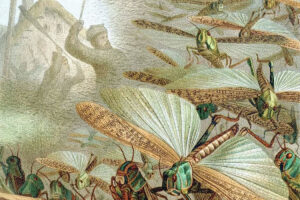I have to admit, we didn’t spend a lot of time studying the Minor Prophets when I was growing up. I’m not sure why – they’re certainly part of the Tanakh, but our Hebrew school teachers focused on the Torah, the Major Prophets, and then sort of jumped over into a couple of selected texts from the Ketuvim, or “writings” – Psalms, Proverbs, Job. As such I’m fairly certain I never studied any of “The Twelve”, starting with the previous book, Hosea, and on. So who was Joel? He was a prophet, obviously, and there’s some contention over when he lived – that range from ninth to fifth century BCE, a pretty significant spread. As such, different biblical historians place the Book of Joel in different orders, but I’ll stick with the order it pops up in this project’s timeline.
The book, reading a few quick summations, focuses on a plague of locusts sent by God to destroy Israel, Judah, and Samaria, at some point or other. Some read this literally, others consider the locusts as a metaphor for invading armies around the region. The early part of the book looks at the effects of the plague on the country, particularly agriculture, reveals God’s reasons for sending it, and then segues into a call for national repentance. It then moves into promises of the banishment of the locusts, or enemies, and prophetic promises of gifts from God to make up for it all, and finally into the punishments to be meted out to surrounding enemies. The last provides the context for why some think the locusts are just a metaphor for those enemies.
- We open on a scene of agricultural destruction, from a three wave plague of grasshoppers, locusts, and grubs. They have stripped the land bare of produce. Interestingly, perhaps fitting to a culture that had become hedonistic, the lament isn’t so much lack of sustenance, but lack of pleasures like wine and exotic fruits and dishes. And though the locusts are clearly to blame, somehow this is all laid at the feet of farmers, who are meant to feel shame at their lack of productivity.
- Keep hope alive! Sound the trumpets! God is coming! And, he’s going to knockback those nasty people to the north… I guess that would be modern day Lebanon and Syria… what the time was Assyria. Good days are coming! Yay God! Quite the shift from the opening page of shame. This may be why some historians seem to feel that the Book of Joel is cobbled together from different “prophets” who lived in different times and places.
- God’s going to send dreams of grandeur to the old men of the faith and visions of the same to the young. It’s not clear what the difference is between dreams and visions, though it appears the latter are more associated with prophecy than the former. Also, there will be a blood moon.
- Egypt and Edom will become desolate wastelands. We get the whole turning your farm implements into weapons bit. And, we find that selling off a young boy for sex involves money, while a young girl can be had for a bottle of wine. It appears that the book ends here, too. After four pages. Which leaves me wondering about all the debate over “how many sections should this book be divided into?” It’s not even a short story, let alone a book.
